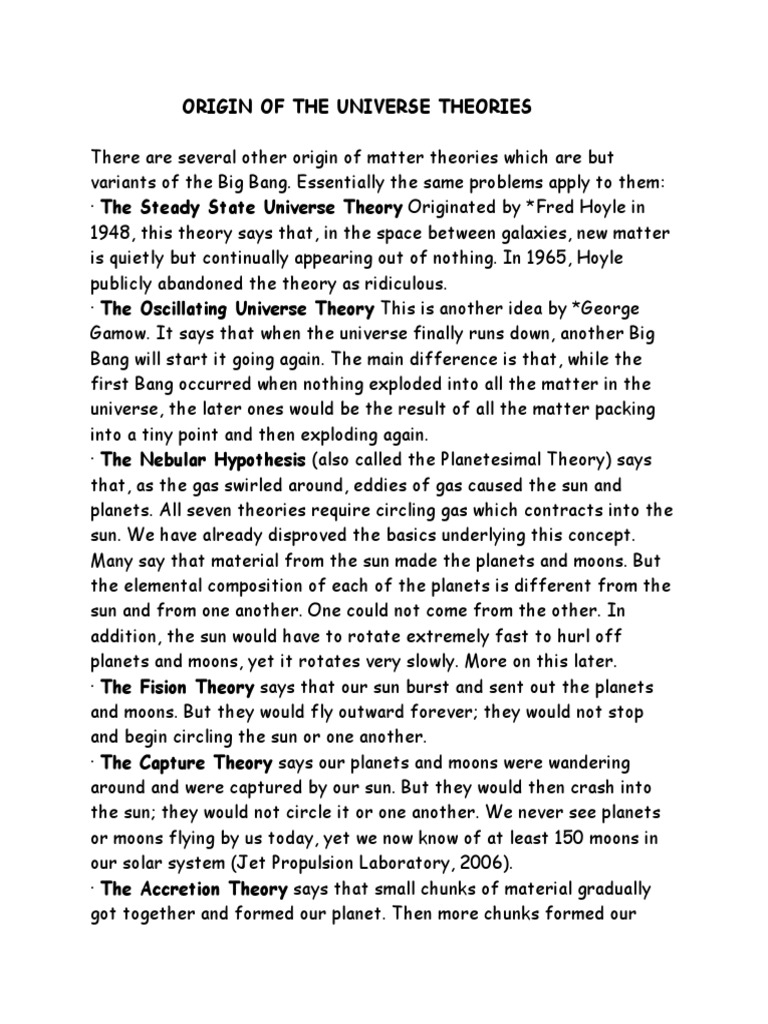In the vast tapestry of existence, the origin of the universe represents the most enticing enigma; it calls to the curious mind like a siren song across the cosmic void. To embark on the journey of formulating your own theory regarding this monumental subject is not merely an academic endeavor but an act of profound creativity. This guide delineates a structured approach to crafting your own cosmological theory, ensuring that your musings resonate within the grand edifice of scientific inquiry.
1. Cultivate a Foundational Understanding of Cosmology
Before you begin to weave your theoretical tapestry, immerse yourself in the rich history of cosmological thought. From the Ancient Greeks, who speculated about the cosmos through geometry, to the big bang theory that revolutionized modern understanding, the lineage of ideas offers a wellspring of inspiration. Familiarize yourself with the prevailing theories, such as inflationary cosmology and the multiverse hypothesis. This knowledge will serve as the bedrock upon which your unique theory will flourish.
2. Embrace Interdisciplinary Approaches
Consider the universe as a multidimensional puzzle whose pieces span various disciplines. Engage with physics, astronomy, and even philosophy while crafting your theory. Reflect on how metaphysical inquiries into existence intersect with scientific rationale. By amalgamating insights from different fields, your theory can achieve a more holistic perspective, illuminating aspects that pure science may overlook.
3. Define Your Theoretical Framework
Your theoretical framework is the canvas on which you will paint. Will your theory revolve around particle physics, asserting that the universe sprang into existence from quantum fluctuations? Or perhaps you envision a cyclical universe, perpetually expanding and contracting, akin to the rhythmic ebb and flow of oceanic tides? Clearly delineating your framework will bring coherence to your conjectures, allowing others to grasp the essence of your ideas with clarity.
4. Formulate Hypotheses
In the realm of science, hypotheses serve as the guiding stars through which theories can be tested. Formulate specific, testable hypotheses that stem from your framework. For example, if your theory posits the influence of dark matter on cosmic structure, you might hypothesize that certain gravitational effects observed in galactic formations can be attributed to yet-undiscovered particles. This process will add rigor to your theoretical edifice.
5. Engage with Empirical Evidence
As you construct your theory, it is paramount to ground your ideas in empirical evidence. Investigate observational data from telescopes, satellite missions, and particle colliders. How does your theory account for redshift, cosmic microwave background radiation, or the observed accelerating expansion of the universe? Ensure that your conjectures harmonize with established observational facts, for a theory devoid of empirical roots is but a fleeting shadow in the light of scientific scrutiny.
6. Develop a Metaphorical Framework
To elucidate your theory and render it more accessible, consider employing metaphors that resonate. The cosmos can be likened to a grand symphony, where each celestial body plays its part in a marvelously intricate arrangement. Your theory may be the conductor, orchestrating disparate elements into a coherent narrative. Such evocative metaphorical imagery helps communicate your ideas in a compelling manner, engaging both the scientific community and the general public.
7. Anticipate Critique and Foster Dialogue
The genesis of a new theory often invites scrutiny. Anticipating challenges to your ideas equips you to defend your stance with rigor. Cultivate a mindset of openness; engage in discussions with peers, scientists, and philosophers. Participate in conferences or forums where you can present your ideas and solicit constructive feedback. Dialogue fosters refinement, transforming initial conjectures into robust theories bolstered by community input.
8. The Role of Creativity in Scientific Inquiry
Science and creativity are intertwined, akin to the dual strands of a double helix. Engaging in creative thought processes activates the latent potential of one’s imagination, leading to novel insights and possibilities. Experiment with thought experiments—hypothetical scenarios that challenge conventional paradigms. Imagining alternative realities can illuminate new pathways of thought that may ground your theory in refreshing originality.
9. Document Your Theory with Precision
Once refined, document your theory meticulously. Clarity and precision are paramount. Structure your narrative coherently, employing a logical progression that guides readers through your argumentation. Use diagrams, mathematical formulations, and illustrative examples as necessary, augmenting the richness of your exposition while ensuring it remains comprehensible. Your document should serve as a solid reference, capable of standing against the scrutiny of time.
10. Contribution to the Cosmic Conversation
Ultimately, crafting a theory about the universe’s origin is more than a personal achievement; it contributes to the collective cosmic conversation that has persisted for millennia. By proposing new ideas, you enrich the scientific narrative and inspire others to seek answers to the profound questions that linger in the vast expanse of the cosmos. Your theory becomes a beacon, illuminating pathways for future explorers of the universe.
In the pursuit of understanding our origins, the journey itself is as fascinating as the discoveries along the way. By daring to dream and challenge the contours of established thought, you may find that the act of theorizing is where you truly connect with the wonders of existence.












